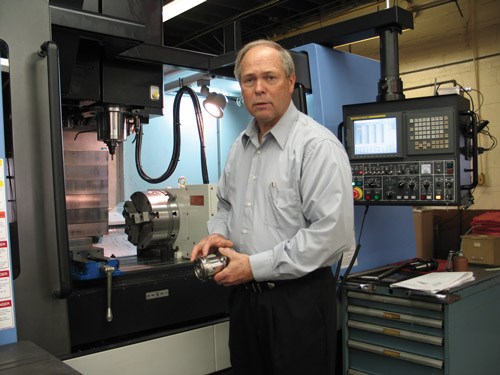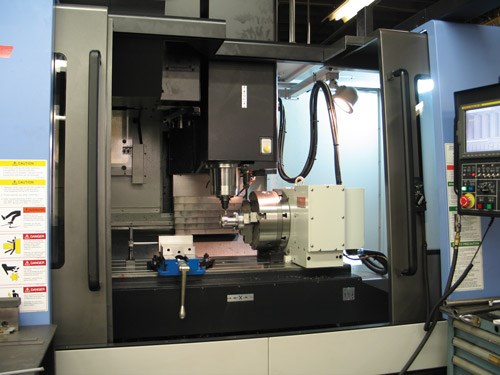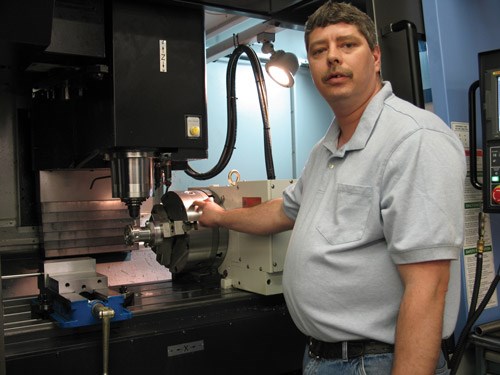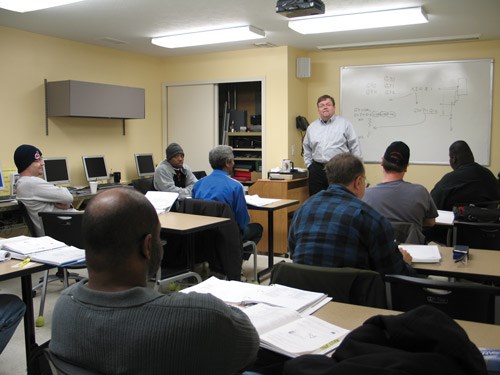Taking Production and Instruction to the 4th Axis
Rotary tables deliver capabilities needed for this shop to meet customer demands while providing an important training tool as well.
For a shop that’s looking to boost its vertical machining center capabilities, the addition of a rotary table can be a cost effective way to take productivity to new levels. One company—both a supplier of parts for bottling, automotive and other production processes and a prototype design services firm—found itself with an immediate need for fourth-axis capabilities to fulfill production for a contract it had been awarded.
“We were in desperate need of a rotary table to meet the production demands,” says Don Borman, co-founder of Borman Enterprises (Cleveland, Ohio). But he also saw another important reason to add the rotary table to the company’s equipment lineup. “The bigger part of our business is the manufacturing end, but that gives us the opportunity to house a training center that’s very functional,” he says. The rotary table was also to become a staple in the process of training the skilled CNC programmers, operators and setup people the company needed, allowing them to see fourth-axis machining at work.
First Table a No-Show
In December 2009, Mr. Borman decided it was time to add fourth-axis capabilities. The company ordered a new vertical machining center with a rotary table so it could bring its fourth-axis work in-house and the training center would be able to incorporate fourth-axis machining into the curriculum. About the same time, the company landed a contract for fourth-axis work, but soon discovered the VMC on order wasn’t going to have the table.
“I found out 2 days before the machine was due here that it wasn’t going to have the fourth axis. That was part of the purchase of the VMC—the table.” That’s when he called CNC Indexing (Wakeman, Ohio).
“I was panicking because the machine had just been installed, and I had the job and material, but I couldn’t do the job because I didn’t have the rotary table,” Mr. Borman says. He checked his options through a distributor. Everyone he contacted said it would take 3 months to get the rotary table he needed. He checked into used equipment. No luck. Finally, his wife found CNC Indexing online.
Mr. Borman says, “What other people told me couldn’t be done (interfacing the controls), Jamie Schwarz at CNC Indexing was positive they could do. And they did it.”
He continues, “Unfortunately, we lost that job because I couldn’t get the rotary table that the machine tool distributor had promised me. Had I known earlier about the missing table, I know CNC Indexing would have been able to have it installed in time. They had the tables in stock, and they filled the void.”
Rotary Table Benefits
Adding a rotary table (fourth axis) or a tilt table (fourth/fifth axes) to a three-axis machine gives a shop the ability to produce multiple face workpieces more easily and quickly. It also provides more flexibility on the type of work that can be produced. A rotary table opens the door for simultaneous rotating and milling of a workpiece, which is needed to perform complex contours and spirals. The most common reason for and the most obvious advantage of adding a rotary table is the ability to access odd angles (down to 0.001 degree) without designing complicated fixturing. Other not so obvious advantages make the rotary table a good choice for many applications:
Higher part accuracy. The more a workpiece is unclamped, rotated and clamped manually in a fixture to access other faces, the greater the buildup of tolerances. A rotary table allows multiple faces to be accessed without moving the workpiece out of a fixture, thus producing features on a part as accurate to each other as the capabilities of the machine and rotary table. This accuracy results in less scrap and higher profits.
Part production time reduction. By adding a rotary table, the cycle time per part is reduced because multiple operations are performed in one clamping. The machine does not need to be stopped so the part can be turned in the fixture. No time is wasted if the operator isn’t standing at the machine to manually rotate the part.
If the same tool is required on multiple faces of the workpiece, it is possible to do so in one tool change. In most cases, it is quicker to rotate the workpiece with the rotary table than to change tools. This reduces the amount of time required for changing tools over the workpiece’s entire production cycle. It may only be seconds, but added up over shifts, weeks, months and years, those seconds turn into hours of saved time. This time savings allows for more parts to be produced or for additional machine time for other work.
Labor savings. Adding a rotary table allows the workpiece to be in production, untouched, for longer periods of time. The operator, then, has time to walk away from the machine and perform other important jobs within the shop. Fewer employees are needed to produce the same amount of output, saving money for the company.
Non-dedicated machine time. The machining center does not have to be dedicated to rotary table work. In the majority of cases, a rotary table will be mounted to the right side of the machine table. The rotary table footprint is such that it leaves the majority of the machine table free to be used for other non-rotary table work. It also allows the machine to be set up for multiple jobs at the same time.
Starting the Training Program
More than 18 years ago, Mr. Borman and partner/company co-founder, Joe Scheall, found they were training machinists in-house just to see them hired elsewhere. That’s when Borman management decided it was time to get paid to train machinists from other companies. They founded the Cleveland Industrial Training Center (CITC).
“We put in a proposal at a plant closing to re-train some of the skilled machinists in the CNC area,” says Tim Duffy, CITC director. “We got the project, which started everything. Don got the certification and got the ball rolling.”
By 1993, Borman Enterprises was certified by the State Board of Career Colleges and Schools. The training services were split off from the company to form the CITC. Classes focus on hands-on training, providing students and graduates access to new CNC machine tools and CAD/CAM systems, as well as quality control equipment and tooling.
“When fourth-axis machining comes up in the classroom, we take the students right out to show a live presentation. It’s live—the chips are flying,” Mr. Borman says. “The instructor brings them up to the working environment to go over the slant bed design of the lathe, or he’ll go over to the rotary table and show them, ‘Here’s the fourth axis, and here’s how you machine with it.’
“These are working machines. That’s really the niche of our training. The problem with other types of training—and I’m all in favor of any kind of education someone can get—is that once the students move on and find themselves in a machine shop environment, they might draw a blank. Suddenly, chips are flying, there’s noise, and they draw a blank. We teach in that environment. The class is working at one machine, and there’s one next to it that is making a part. We’re simulating a working environment. We provide timely and productive training that’s real.”
Table Adds Flexibility, Capacity
When it was originally installed, the Golden Sun 10-inch rotary table was set up as a typical fourth axis at a right angle for drilling 30 holes on nozzles designed and made by Borman for a large bottling customer.
The company now has the rotary table laid down on a sine bar at a 20-degree angle, which presents the nozzle at a 20-degree angle, and Borman compounds it another 14 degrees. Currently it is not cutting chips, but it’s set up for the next batch of nozzles. Meanwhile, the company has a vise on the other end of the machine table, which allows conventional VMC work.
“Being a job shop, we have to be versatile,” Mr. Borman says. “When this one account wants samples, they need them now. We have to have the setup, which takes 3 hours, ready to go.”
CNC Indexing’s Jamie Schwarz says the compact design of the Golden Sun table helps in that regard. “It’s very easy to work with as far as space. It doesn’t take up the whole machining envelope.” That leaves ample open table space for maneuverability and flexible use.
Mr. Borman says he’s had a good track record with Golden Sun. And the new rotary table did not disappoint. “It’s just a user-oriented, price competitive table. That’s what I look at more than anything. I don’t think we’ve ever had a maintenance issue on the 10-inch table in 3 years. It keeps running and running.” The company has since gained still more capacity by purchasing a new 12.5-inch rotary table.
Scheduling Training Machine Time
With 16 CNCs (two dedicated to training) and 20 operators during two shifts, students are scheduled on any machines with open time. “We schedule the students just like we would a job. Right now, both fourth-axis machines are not cutting chips, which is unusual,” Mr. Borman says. “Next week at this time, both will be busy, and we could almost use another one. If it weren’t for our added capacity, we would probably have had to turn down training folks.”
But most of the students aren’t quite ready for fourth-axis work. To date, learning fourth-axis methods is more lecture than hands-on. It can be incorporated into a class project during the standard 17-week program, but Mr. Borman says they can only cover so much.
That’s no surprise to Mr. Schwarz, who’s been in the CNC machining business in one aspect or another since 1994. Setting up machining centers with machine tool accessories throughout the U.S. and training machine operators to use them brings him in contact with a lot of machinists. The skill levels, Mr. Schwarz says, are all over the board.
“That’s one of the reasons we were excited about working with Borman and CITC. A lot of companies out there really need machinists with higher skills. So, there are a lot of opportunities for machinists with the skills this training center can give them. We like being involved in that,” he says.
But fourth-axis work? Mr. Schwarz says that’s an advanced process. “It’s a good thing for them to observe the work and get familiar with the basics. But I’d say the majority of machining trainees would need more time with the engineering side of it before they’d be ready.”
Mr. Borman agrees. “We might have one or two students out of a class of ten or 12 who can really appreciate what the fourth axis can do. For the others, it may be a little more complex than the intent of this program. But it’s available to them if they’re ready to progress beyond three axes.”
More Trainees with Experience
These days, the CITC finds that more of its students arrive with some industrial experience. Word of mouth gets them there.
“We’ll talk to the general public as well as 30-year machinists who have never touched CNC in their lives and just got laid off,” Mr. Duffy says. “We can take a guy like that and turn him around in 4 months and get him a good job.”
Although the center focuses on hands-on training with machine tools, Mr. Borman, Mr. Duffy and Mr. Schwarz feel the engineering aspects are critical for experienced machinists. “We wanted to bring the engineering stage into this class, too, so it would appeal to the entry-level person but also interest a seasoned machinist looking to round out his programming capabilities,” Mr. Borman says.
“Regardless of what an individual brings us, we can raise their level, no matter what their starting point is,” Mr. Duffy adds. “Even within a given class of 12 to 14 students, we can identify their strengths and weaknesses and appeal to everyone. We don’t just take a cookie-cutter approach to every class. We have an obligation to every student to ensure they graduate from the program and get a good job.”
Students who are completely new to machining are given an entrance exam to assess skills with fractions, decimals and percentages. If those abilities are there, he says, the center can train them. The center also provides on-site training for area companies. Classes can be as simple as a 20-hour shop math class or blueprint reading to customized instruction like the 45-hour, highly specialized mill training class for Swagelok.
Borman Enterprises often hires students from CITC. In 2007, it opened another instructional center, the Akron CNC Training Center, conducting classes and lab projects at S.C. Manufacturing. In 2010, CITC began the first and only CNC Swiss machine operator training program in Ohio.
“We were happy to take that call from Borman for a lot of reasons,” Mr. Schwarz says of his first conversation with Mr. Borman about the rotary table. “But working with really knowledgeable engineers like Don and Tim, and seeing what they’re accomplishing with these training centers, it’s a great thing. It’s great for the industry, it’s great for this region, and it’s great for the guys in training who move on to good jobs.”
— Absolute Machine Tools Inc.
Related Content
Parting Off: The Case for Standardizing on Sawing
The value of rotary saw cutting for parting off operations could boil down to simple economics paired with process efficiency gains.
Read MoreStarting Small with Automation
Quick-change workholding and flexible robotic automation started this small shop on the path to success.
Read MoreData Matrix Codes Offer Cutting Tool Traceability
A company’s quest to discover errors in a manufacturing process has led to printing data matrix codes on its cutting tools that provide a wealth of information for both the user and this cutting tool manufacturer.
Read MoreBroaching Tool Technology For Lathes Used to Slot Inconel Parts
This shop finds value in using an indexable-insert-style broaching tool to create blind-hole slots in heat-treated Inconel aerospace parts on a CNC lathe.
Read MoreRead Next
Showrooms as Classrooms
One issue that we hear from technical schools and the companies that employ their graduates is that the students often aren’t exposed to the latest technology. Too many of these future machinists need additional training from the shop that hires them. And sadly, in too many cases this additional training may have to include remedial classes such as reading, writing and math before the employee even steps onto the shop floor.
Read MoreA Tooling Workshop Worth a Visit
Marubeni Citizen-Cincom’s tooling and accessory workshop offers a chance to learn more about ancillary devices that can boost machining efficiency and capability.
Read MoreDo You Have Single Points of Failure?
Plans need to be in place before a catastrophic event occurs.
Read More.png;maxWidth=970;quality=90)



















.png;maxWidth=300;quality=90)







